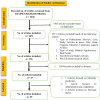A scoping review of machine learning for sepsis prediction- feature engineering strategies and model performance: a step towards explainability
- PMID: 38802973
- PMCID: PMC11131234
- DOI: 10.1186/s13054-024-04948-6
A scoping review of machine learning for sepsis prediction- feature engineering strategies and model performance: a step towards explainability
Abstract
Background: Sepsis, an acute and potentially fatal systemic response to infection, significantly impacts global health by affecting millions annually. Prompt identification of sepsis is vital, as treatment delays lead to increased fatalities through progressive organ dysfunction. While recent studies have delved into leveraging Machine Learning (ML) for predicting sepsis, focusing on aspects such as prognosis, diagnosis, and clinical application, there remains a notable deficiency in the discourse regarding feature engineering. Specifically, the role of feature selection and extraction in enhancing model accuracy has been underexplored.
Objectives: This scoping review aims to fulfill two primary objectives: To identify pivotal features for predicting sepsis across a variety of ML models, providing valuable insights for future model development, and To assess model efficacy through performance metrics including AUROC, sensitivity, and specificity.
Results: The analysis included 29 studies across diverse clinical settings such as Intensive Care Units (ICU), Emergency Departments, and others, encompassing 1,147,202 patients. The review highlighted the diversity in prediction strategies and timeframes. It was found that feature extraction techniques notably outperformed others in terms of sensitivity and AUROC values, thus indicating their critical role in improving sepsis prediction models.
Conclusion: Key dynamic indicators, including vital signs and critical laboratory values, are instrumental in the early detection of sepsis. Applying feature selection methods significantly boosts model precision, with models like Random Forest and XG Boost showing promising results. Furthermore, Deep Learning models (DL) reveal unique insights, spotlighting the pivotal role of feature engineering in sepsis prediction, which could greatly benefit clinical practice.
Keywords: Clinical outcome; Critical features; Feature engineering; Machine learning; Performance evaluation; Scoping review; Sepsis prediction.
© 2024. The Author(s).
Conflict of interest statement
There is no competing interest declared by all authors.
Figures






Similar articles
-
Prediction of sepsis mortality in ICU patients using machine learning methods.BMC Med Inform Decis Mak. 2024 Aug 16;24(1):228. doi: 10.1186/s12911-024-02630-z. BMC Med Inform Decis Mak. 2024. PMID: 39152423 Free PMC article.
-
Machine Learning-Based Early Warning Systems for Clinical Deterioration: Systematic Scoping Review.J Med Internet Res. 2021 Feb 4;23(2):e25187. doi: 10.2196/25187. J Med Internet Res. 2021. PMID: 33538696 Free PMC article.
-
Machine learning algorithms for early sepsis detection in the emergency department: A retrospective study.Int J Med Inform. 2022 Apr;160:104689. doi: 10.1016/j.ijmedinf.2022.104689. Epub 2022 Jan 20. Int J Med Inform. 2022. PMID: 35078027
-
Real-Time Prediction of Sepsis in Critical Trauma Patients: Machine Learning-Based Modeling Study.JMIR Form Res. 2023 Mar 31;7:e42452. doi: 10.2196/42452. JMIR Form Res. 2023. PMID: 37000488 Free PMC article.
-
Machine learning for the prediction of sepsis-related death: a systematic review and meta-analysis.BMC Med Inform Decis Mak. 2023 Dec 11;23(1):283. doi: 10.1186/s12911-023-02383-1. BMC Med Inform Decis Mak. 2023. PMID: 38082381 Free PMC article.
Cited by
-
Dynamic risk stratification and treatment optimization in sepsis: the role of NLPR.Front Pharmacol. 2025 Apr 2;16:1572677. doi: 10.3389/fphar.2025.1572677. eCollection 2025. Front Pharmacol. 2025. PMID: 40242435 Free PMC article.
-
The influence of different factors on the bond strength of lithium disilicate-reinforced glass-ceramics to Resin: a machine learning analysis.BMC Oral Health. 2025 Feb 18;25(1):256. doi: 10.1186/s12903-025-05590-6. BMC Oral Health. 2025. PMID: 39966781 Free PMC article.
-
A methodological systematic review of validation and performance of sepsis real-time prediction models.NPJ Digit Med. 2025 Apr 7;8(1):190. doi: 10.1038/s41746-025-01587-1. NPJ Digit Med. 2025. PMID: 40189694 Free PMC article.
-
Explainable machine learning model for prediction of 28-day all-cause mortality in immunocompromised patients in the intensive care unit: a retrospective cohort study based on MIMIC-IV database.Eur J Med Res. 2025 May 3;30(1):358. doi: 10.1186/s40001-025-02622-3. Eur J Med Res. 2025. PMID: 40319284 Free PMC article.
-
Artificial intelligence in hospital infection prevention: an integrative review.Front Public Health. 2025 Apr 2;13:1547450. doi: 10.3389/fpubh.2025.1547450. eCollection 2025. Front Public Health. 2025. PMID: 40241963 Free PMC article. Review.
References
Publication types
MeSH terms
LinkOut - more resources
Full Text Sources
Medical

